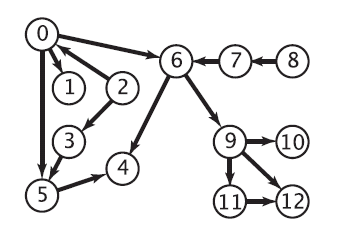这里要从一道题目开始说起
题目大意:我们的系统现在有一连串的事务需要处理,但事务之间存在依赖性,问我们的事务应该以怎样的顺序进行处理。
第一行读入两个整数,节点总数m,依赖项的个数n;接下来读入n行数据,每行数据:A size BCDE,表示BCDE完成以后才能处理A,size表示接下来的节点个数
输入:
13 11
1 1 0
5 2 0 3
0 1 2
3 1 2
4 2 5 6
6 2 0 7
7 1 8
9 1 6
10 1 9
11 1 9
12 2 9 11
拓扑排序的定义及其充要条件
定义:将有向图中的顶点以线性方式进行排序。即对于任何连接自顶点u到顶点v的有向边uv,在最后的排序结果中,顶点u总是在顶点v的前面。
简单来说,我们以选课为例,假如我想选修机器学习,选课系统判断我从未选修过数据结构和算法,选课失败。这里的数据结构和算法就相当与u0和u1,而这里的机器学习就相当于v。
但我很想选修机器学习,所以我只能先选修数据结构和算法,等这两个选修完成以后,再取选修机器学习。这个过程以算法的形式描述出来的结果就被称为拓扑排序。
假如因为系统问题,学校的选课系统在我选修数据结构的时候要求我已经选修机器学习。这个时候选课无法继续进行,因为它中间存在互相依赖的关系,从而无法确定谁先谁后。在有向图中,这种情况被描述为存在环路。因此,一个有向图能被拓扑排序的充要条件就是它是一个有向无环图(DAG:Directed Acyclic Graph)。
拓扑排序的具体实现
Kahn算法O(N + E)
维基百科上关于Kahn算法的伪码描述:
L← Empty list that will contain the sorted elements
S ← Set of all nodes with no incoming edges
while S is non-empty do
remove a node n from S
insert n into L
foreach node m with an edge e from nto m do
remove edge e from thegraph
ifm has no other incoming edges then
insert m into S
if graph has edges then
return error (graph has at least onecycle)
else
return L (a topologically sortedorder)
思路非常简单,我们首先找到所有入度为0的节点,当如到队列当中,每次输出一个入度为0的节点,紧接着循环遍历由该节点引出的所有边对应的节点,将该节点的入度减1,如果该顶点的入度在减去1之后为0,那么也将这个顶点放到入度为0的集合中。然后继续从队列中取出一个顶点,知道队列为空。
在这个过程中记录遍历的节点个数,如果输出的节点个数等于输入的节点个数,此时我们已经完成了拓扑排序;如果少于输入的节点个数,说明图中至少存在一条环路。
细节代码:
#include <map>
#include <queue>
#include <iostream>
using namespace std;
bool solve()
{
int n;
int nodeSize;
cin >>nodeSize >> n;
int cur;
int rely;
int numRely;
vector<int> numChild(nodeSize, 0);//每个节点的入度个数
vector<vector<int> > reverseMap(nodeSize);//出度表
queue<int> input0;
vector<int> result;
for (int i = 0; i < n; ++i)
{
cin >> cur >> numRely;
numChild[cur] = numRely;
for(int j = 0; j < numRely; ++j)
{
cin >> rely;
reverseMap[rely].push_back(cur);
}
}
for(int i = 0; i < nodeSize; ++i)
if(numChild[i] == 0)
input0.push(i);
int count = 0;
while(!input0.empty())
{
++count;
cur = input0.front();input0.pop();
result.push_back(cur);
for(int i = 0; i < reverseMap[cur].size(); ++i)
{
rely = reverseMap[cur][i];
if(--numChild[rely] == 0)
input0.push(rely);
}
}
if(count != nodeSize)
{
cout<< count<< endl;
return false;
}
for(int i = 0; i < count; ++i)
cout<< result[i];
return true;
}
int main()
{
if(!solve())
cout<<"circle exist"<<endl;
return 0;
}
output: 2 8 0 3 7 1 5 6 4 9 10 11 12基于DFS的拓扑排序算法O(N + E)
维基百科上的伪码描述:
L ← Empty list that will contain the sorted nodes
S ← Set of all nodes with no outgoing edges
for each node n in S do
visit(n)function visit(node n)
if n has not been visited yet then
mark n as visited
for each node m with an edgefrom m to ndo
visit(m)
add n to
算法成立的简单解释:参考树的后序遍历(每个出度为0的节点作为根),假定节点输出以后就会消失,那么此刻这棵树的打印的每个节点都可以保证自己没有孩子节点。
Detail:
考虑任意的边v->w,当调用dfs(v)的时候,有如下三种情况:
- dfs(w)还没有被调用,即w还没有被mark,此时会调用dfs(w),然后当dfs(w)返回之后,dfs(v)才会返回
- dfs(w)已经被调用并返回了,即w已经被mark
- dfs(w)已经被调用未返回,在之后的调用中出现调用dfs(v)的情况
很明显,第三种情况的出现意味着有向图中出现了环路,从而该图就不是一个有向无环图(DAG),而我们已经知道,非有向无环图是不能被拓扑排序的。而无论是第一种情况还是第二种情况,w都会在v之前被输出。
细节代码:
#include <vector>
#include <iostream>
using namespace std;
vector<int> result;
void dfsVisit(vector<vector<int> >& mapin, vector<bool>& visited, int cur)
{
visited[cur] = 1;
for(int i = 0; i < mapin[cur].size(); ++i)
{
if(!visited[mapin[cur][i]])
dfsVisit(mapin, visited, mapin[cur][i]);
}
result.push_back(cur);
}
bool dfs(vector<vector<int> >& mapin, vector<bool>& visited, int cur)
{
visited[cur] = 1;
for(int i = 0; i < mapin[cur].size(); ++i)
{
if(!visited[mapin[cur][i]])
dfs(mapin, visited, mapin[cur][i]);
else
return false;
}
return true;
}
bool DAG(vector<vector<int> >& mapin, vector<int>& outGoing)
{
int nodeSize = mapin.size();
for(int i = 0; i < outGoing.size(); ++i)
{
vector<bool> visited(nodeSize, 0);
if(!dfs(mapin, visited, outGoing[i]))
return false;
}
return true;
}
bool solve()
{
int n;
int nodeSize;
cin >>nodeSize >> n;
int cur;
int rely;
int numRely;
vector<bool> visited(nodeSize, 0);//访问标记
vector<int> outGoing(nodeSize, 0);//每个节点的出度个数
vector<vector<int> > mapin(nodeSize);//入度表
vector<int> outGoing0;
for (int i = 0; i < n; ++i)
{
cin >> cur >> numRely;
for(int j = 0; j < numRely; ++j)
{
cin >> rely;
mapin[cur].push_back(rely);
outGoing[rely]++;
}
}
for(int i = 0; i < nodeSize; ++i)
if(outGoing[i] == 0)
outGoing0.push_back(i);
if(!DAG(mapin, outGoing0))
return false;
for(int i = 0; i < outGoing0.size(); ++i)
dfsVisit(mapin, visited, outGoing0[i]);
for(int i = 0; i < nodeSize; ++i)
cout<< result[i]<< " ";
return true;
}
int main()
{
if(!solve())
cout<< "circle exist"<< endl;
return 0;
}
output: 2 0 1 3 5 8 7 6 4 9 10 11 12
两种实现算法的总结:
对于基于DFS的算法,是根据出度表构建的,从出度为0的节点递归。Kahn算法,是根据入度表构建的,从入度为0的节点开始遍历。
Kahn算法不需要检测图为DAG,如果图为DAG,那么在出度为0的集合为空之后,遍历的节点个数少于图中节点的总数,这就说明了图中存在环路。而基于DFS的算法需要首先确定图为DAG,当然也能够做出适当调整,让环路的检测和拓扑排序同时进行,毕竟环路检测也能够在DFS的基础上进行。
二者的复杂度均为O(V+E)
环路的检测和拓扑排序同时进行:
#include <vector>
#include <iostream>
using namespace std;
vector<int> result;
bool dfs(vector<vector<int> >& mapin, vector<bool>& visited, vector<bool>& DAGValid, int cur)
{
visited[cur] = 1;
DAGValid[cur] = 1;
for(int i = 0; i < mapin[cur].size(); ++i)
{
if(!visited[mapin[cur][i]])
dfs(mapin, visited, DAGValid, mapin[cur][i]);
else if(DAGValid[mapin[cur][i]])
return false;
}
result.push_back(cur);
}
bool solve()
{
int n;
int nodeSize;
cin >>nodeSize >> n;
int cur;
int rely;
int numRely;
vector<bool> visited(nodeSize, 0);//访问标记
vector<int> outGoing(nodeSize, 0);//每个节点的出度个数
vector<vector<int> > mapin(nodeSize);//入度表
vector<int> outGoing0;
for (int i = 0; i < n; ++i)
{
cin >> cur >> numRely;
for(int j = 0; j < numRely; ++j)
{
cin >> rely;
mapin[cur].push_back(rely);
outGoing[rely]++;
}
}
for(int i = 0; i < nodeSize; ++i)
if(outGoing[i] == 0)
outGoing0.push_back(i);
for(int i = 0; i < outGoing0.size(); ++i)
{
vector<bool> DAGValid(nodeSize, 0);//判断环存在的数组
dfs(mapin, visited, DAGValid, outGoing0[i]);
}
for(int i = 0; i < nodeSize; ++i)
cout<< result[i]<< endl;
return true;
}
int main()
{
if(!solve())
cout<< "circle exist"<< endl;
return 0;
}行文思路参考:http://blog.csdn.net/dm_vincent/article/details/7714519

























 1392
1392

 被折叠的 条评论
为什么被折叠?
被折叠的 条评论
为什么被折叠?








